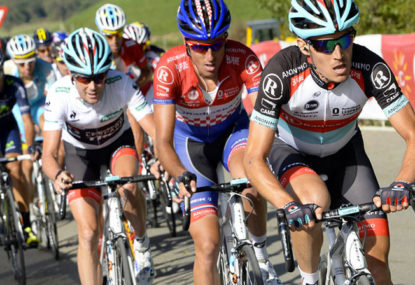La Vuelta a Espana reaches her penultimate stage and arguably the Queen Stage of the 2013 race route, in my opinion, with the peloton journeying 142.2 kilometres from the city of Avilés to the infamous Hors catégorie Alto de L’Angliru.
Whilst only a relatively short stage, the ascent of the Alto de L’Angliru will more than compensate.
Currently the weather should be either sunny and fine or overcast, with temperatures around 20-degrees celsius.
Though there is the possibility or fog and precipitation on the climb of the Alto de L’Angliru.
There will be the potential for crosswinds during the stage at various points throughout the parcours, however, the wind is currently forecast to be rather light.
Featuring just 2,303 metres of accumulated climbing, Stage 20 seems easier than some of the Pyrenean stages. However, the presence of the Alto de L’Angliru contributes to almost half of that statistic.
Nether the less the peloton still have to summit three other categorised climbs spread throughout the stage.
First on the agenda will be the 3rd Category Alto de la Cabruñana, which begins some 40.3 kilometres in to Stage 20.
At a length of 5.2 kilometres and at an average gradient of 6.6 percent it will be a mere mole hill compared to the L’Angliru.
It will be followed by the ascent of the 2nd Category Alto Tenebredo at the 75.7-kilometre mark, with slopes that are just 3.7 kilometres in distance, but feature an average gradient of 10.5 percent.
After descending from the summit of the Alto Tenebredo the peloton will continue steadily climbing to the beginning of the 1st Category Alto del Cordal.
The 5.3 kilometres may not appear, on paper, to be much in comparison to some of the Pyrenean mountain passes but when you examine the climb in detail you discover just how challenging it could be.
With an average gradient of 9.6 percent, a maximum gradient of 12 percent, and a gradient which only dips below 8 percent once with a short section at 6.67 percent.
There will be no respite for the peloton, with the Alto del Cordal’s descent counting down the kilometres to the commencement of the Alto de L’Angliru.
The descent crashes straight in to the ascent of the L’Angliru, meaning the peloton will have to keep their legs spinning during the descent down from the summit of the Alto del Cordal.
Beginning with a gradient of 7.5 percent, the Hors catégorie Alto de L’Angliru shall take no prisoners.
This infamous ascent, which featured in the 2011 Vuelta a Espana, measures 12.2 kilometres in length at an average gradient of 10.2 percent.
With several sections at or above 20 percent, up to a maximum gradient of 23.5 percent, there will be no escaping from the pain.
The L’Angliru features a short respite roughly five to six kilometres in to the climb.
However, apart from two sections of -2.5 percent, and 5 percent, the gradient shall never dip below 6 percent until the final kilometre.
Tthe majority of the climb is at gradients of above 10 percent, and the remaining 6.5 kilometres of the climb the most arduous and gruelling section of the L’Angliru.
Thankfully the final five to six hundred metres of the Alto de L’Angliru are classified as being downhill, with gradients of -5 percent and -1.67 percent. H
owever, with a one kilometre section roughly 2.2 kilometres from the finish line featuring gradients between 13 percent and 23.5 percent, even reaching the finishing line will be a titanic struggle.
There is a punishing section of 21 percent thrown in for good measure near the Flamme Rouge.
It is very rare that a breakaway claims the victory in a stage concluding upon the Alto de L’Angliru.
With the stage victor usually the eventual winner of la Vuelta a Espana or his closest rival, it is understandable given the monstrous nature of the climb.
So we should expect one of the stronger General Classification riders to snatch the honour and glory of a stage victory atop the Alto de L’Angliru.
My personal favourite for the stage victory has to be Joaquim Rodriguez of Team Katusha.
Whilst the Catalonian cyclist has never quite reached the height of his climbing prowess during this year’s Vuelta a Espana, as a thoroughbred climber he should potentially struggle the least.
Affectionately nicknamed ‘Purito’, he should also be buoyed by his stage victory on Stage 19, where he looked to be in superb form.
The Bookmaker’s favourite for the stage victory will arguably be Christopher Horner of Radioshack-Leopard.
The veteran American cyclist has rarely shown any signs of weakness and looks unlikely to begin to do so just one stage short of Madrid.
Horner’s climbing has been particularly impressive when you considering how often he has remained out of the saddle whilst doing ascending.
Team Movistar’s Alejandro Valverde will potentially be sensing blood in the water with Vincenzo Nibali showing signs of weakness in consecutive stages.
However, the time advantage the Italian currently holds over Valverde means the Spaniard would need daily form to be in his favour.
Valverde arguably does not handle gradient quite this steep very well, but we can expect him to fight all the way.
Despite displaying signs of losing the 2013 Vuelta a Espana, we cannot completely write off Team Astana and Vincenzo Nibali.
The self-styled ‘Shark of Messina’ will battle the entire distance of the stage to claim the overall victory.
Form shall not be in the Italian’s favour, but in such an unpredictable la Vuelta a Espana why should we write off a surprise on the penultimate day?





























































































